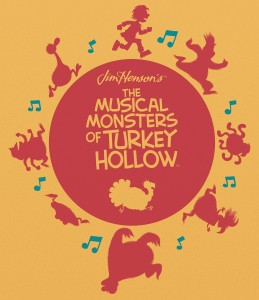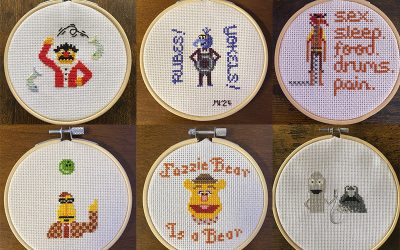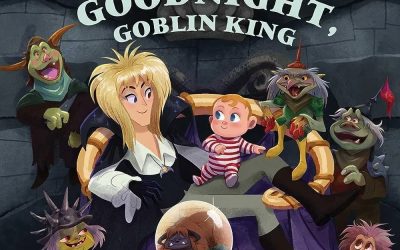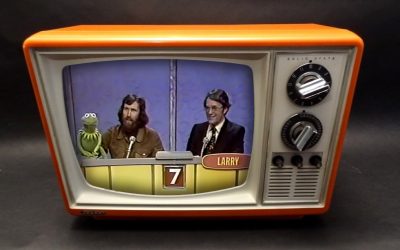The fact that there are still unproduced scripts written by Jim Henson and Jerry Juhl in the world blows my mind. Yes, we were previously denied a pre-Sesame Street special featuring a team of musical monsters, a Joe Raposo soundtrack, real outdoor locations, and a whole bunch of turkeys, but thanks to the efforts of The Jim Henson Company, Archaia, and writer/illustrator Roger Langridge, The Musical Monsters of Turkey Hollow has finally been shared with the world.
The new graphic novel, based off of Jim Henson and Jerry Juhl’s 1968 script, is in stores this week, and a few of your ToughPigs pals (Joe and Anthony) read it and argued over who got to review it. So instead of fisticuffs, we teamed up to review the book together. Which you’re about to read. In, like, 10 seconds.
Please keep in mind that there are very minor spoilers below. Nothing that will ruin the book or the story, but you may want to buy your copy as soon as possible. For so many reasons.
Joe: Turkey Hollow! This is a thing I’d never heard of before a few months ago, and now it’s one of my favorite of Jim Henson’s non-Muppet works.
Anthony: Agreed! Two years ago, Archaia released Tale of Sand, another graphic novel based on a Jim Henson/Jerry Juhl screenplay. I love Tale of Sand a lot – and someday I’m going to write an article for Tough Pigs about how it forms a brilliant, perfect trilogy with “Time Piece” and “The Cube” – but at the time I was disappointed that it wasn’t much of a comedy.
Well, “The Musical Monsters of Turkey Hollow” is a comedy, and it’s delightful.
Joe: Right, it’s not so much something in the vein of “Time Piece” as it is “Fraggle Rock”. And written, what, 15 years before Jim decided to create a world of underground music-loving creatures? It’s a completely different part of Jim and Jerry’s talent, and I’m really glad to see Archaia and Henson publish stuff like this. All sorts of Jim/Jerry genres.
Anthony: So we’ve established the genre, but we should probably touch on the actual story.
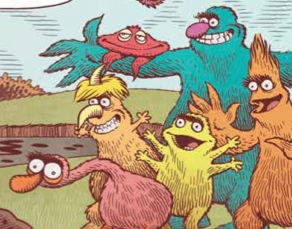 Joe: In a nutshell, this is a graphic novel about a small New Hampshire town that gets infested with monsters, panic ensues, and there’s a massive jailbreak. And lots of turkeys.
Joe: In a nutshell, this is a graphic novel about a small New Hampshire town that gets infested with monsters, panic ensues, and there’s a massive jailbreak. And lots of turkeys.
Anthony: Our point-of-view characters are preteen Timmy Henderson, his teenage sister Anne, and their aunt Cly. Timmy’s the first person in town to meet the monsters, and the central conflict concerns a Ebenezer Scooge-like villain named Eldridge Sump who wants to drive the Hendersons off of their land.
Joe: There’s a group of monsters (who also seem to be aliens, but it’s never really explored, and that’s totally okay) who make music (which, by the way, is a hard thing to pull off in a comic book) and help Timmy and his family bring a little color to their sepia-toned lives.
Anthony: That’s about it. You mentioned the music, so let’s start there. The musical sections are really, really helped by the fact that Archaia got Roger Langridge to adapt and draw the story. Langridge, of course, wrote and drew the Muppet Show Comic Book for BOOM! Studios a few years ago, and every issue of that featured original songs. If there’s anyone in the world who knows how to write and stage a Muppet-style musical number on paper, it’s Langridge.
Joe: Yeah, he nails the musical stuff, which somehow sounds a lot more like a song than a poem surrounded by musical notes, and he also has the perfect writing style for that family-friendly, Fraggle-like storytelling that this book requires.
I know a few people didn’t care for the musical numbers in Langridge’s Muppet Show Comic Book, but considering how important music is to “Turkey Hollow”, the final product really is perfect.
Anthony: Absolutely. I’m especially fond of the way he portrays each monster’s distinct voice, with each one speaking in a different font, size, and color. It reminded me of the way the characters spoke in Pogo by Walt Kelly, which is always a good thing to be reminded (and maybe the Muppet-iest comic strip of all time.)
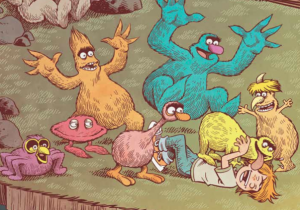 Joe: Who was your favorite Musical Monster?
Joe: Who was your favorite Musical Monster?
Anthony: NRLLL. He’s just such a cute li’l guy, with that combination of beak and tentacles.
Joe: I like BOWB. Maybe because he looks a lot like Herry Monster, but probably with a low bass singing voice. And less of a penchant for destruction.
Anthony: While we’re on the subject of the monsters themselves, let’s talk about Langridge’s designs. A look at those photos of the original puppets with Cheryl and Lisa Henson reveals that these monsters don’t really resemble those ones from the ‘60s. The Henson influence is there, of course, but basically Roger Langridge designed these characters in his own style.
That’s a big change from his Muppet Show work, and a welcome one. I loved his art in that book, but I know that a lot of people thought it was too off-model to really feel like the Muppets. That isn’t a problem here, because no one’s ever seen these characters before.
Joe: I’m not sure I 100% agree. When you look at the original puppets, you see all the characters there. Sure, Langridge gave Snerf a fat little body to make him QUONCK, but everyone’s there. And they obviously needed some Langridge-style changes to adapt them to the comic book medium, but the essence of the monsters are all in those old photos.
Anthony: Yeah, that’s true. I guess what I mean is that the Langridge-style changes won’t cause the controversy they did back in 2009, because this graphic novel is its own beast (its own monster, if you will) without the baggage that comes from using well-known Muppets.
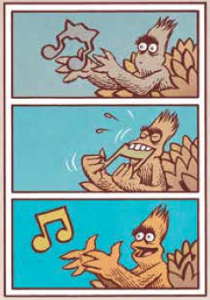 Joe: One thing I found really interesting is that they’re all pretty dark and dirty-looking in those old photos. In the preview comic sold by Archaia at San Diego Comic Con earlier this year, there’s a bit where colorist Ian Herring says that the original idea was to have the monsters become more and more colorful as they make music. That’s really subtle, but it’s still there in the comic. Take a look at the panels where Timmy is playing his guitar in front of the monsters for the first time, and you see a grey SHOOP grab his twisted musical note, straighten it out, and then when he releases it, he’s suddenly become a bright orange.
Joe: One thing I found really interesting is that they’re all pretty dark and dirty-looking in those old photos. In the preview comic sold by Archaia at San Diego Comic Con earlier this year, there’s a bit where colorist Ian Herring says that the original idea was to have the monsters become more and more colorful as they make music. That’s really subtle, but it’s still there in the comic. Take a look at the panels where Timmy is playing his guitar in front of the monsters for the first time, and you see a grey SHOOP grab his twisted musical note, straighten it out, and then when he releases it, he’s suddenly become a bright orange.
I wonder if Jim was planning to do something similar with the puppets. Would they have all gotten bright new swatches of fur as the special went on?
Anthony: That’s an interesting idea. I would have liked to see that play out in the special.
On the subject of “How would Jim have done it?,” you’ve mentioned Fraggle Rock as a comparison, but the Henson project this reminds me of the most is “Muppet Musicians of Bremen,” another Henson/Juhl special from around the same time they were working on this story.
That special, like this one, had a number of human characters. But there, there were played by people with Muppet-esque masks on their faces. Part of me wonders if Timmy and the other humans might have used that effect, or just been actual puppets (like Fred the Elf or the step-sisters from Hey Cinderella).
Joe: I can totally see that. Partly because Sump reminds me a lot of Caleb Siles. I bet they would’ve used real humans for the Henderson family, as well as the Mayor/Sheriff/storeowner, who ended up being one of my favorite characters in the book. But yeah, the universal message of “Music brings everything together” is pretty central in both stories. As well as every episode of Fraggle Rock.
Correct me if I’m wrong, but this would’ve been Jim’s first attempt at shooting a story with puppets in the real world.
Anthony: I won’t correct you, for you are already correct.
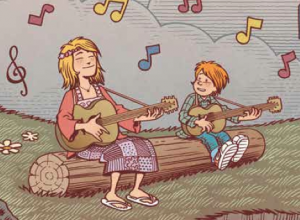 Joe: For that reason alone, I bet he would’ve relied pretty heavily on human cast members. It’s like he would’ve been dipping his toe into the waters that would soon enough become The Muppet Movie.
Joe: For that reason alone, I bet he would’ve relied pretty heavily on human cast members. It’s like he would’ve been dipping his toe into the waters that would soon enough become The Muppet Movie.
Anthony: I bet you’re right.
Joe: I also wonder if Sump would have eventually been replaced with Taminella. Because 1968.
Anthony: I can’t imagine Taminella in a semi-realistic, rural America setting like this. She’s a fairy tale character, and that was the only place Henson and Juhl ever used her.
Joe: Fair enough. I mean, I think Taminella can haunt any sort of story, because she’s just that evil. But I guess we’ll never know. Until Archaia publishes “Taminella: The Popover Story”.
Anthony: “Taminella vs. Star Boppers”.
Joe: I would pay all the moneys for that. Someone get Amy Mebberson on the phone.
So, let’s talk about the music, which is pretty important since it’s the first word in the title, after “the”. The songs were originally supposed to be written by Joe Raposo (featuring Charlie Byrd on the guitar), who our readers may recognize as being the guy who wrote every memorable song ever recorded, and it would have been absolutely incredible to get that collaboration one more time in that era of Henson history. When you read the songs and musical numbers, what were you hearing in your head?
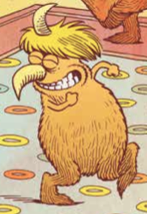 Anthony: Well, I was certainly thinking about Joe Raposo a lot. Langridge’s songs aren’t really in Raposo’s style, but it’s easy to imagine Raposo’s song serving the same story purpose. This is especially true of the big number about halfway through (sung by Timmy, Anne, and the monsters). I pictured that as a big, spirited number in the vein of “Run, Run.”
Anthony: Well, I was certainly thinking about Joe Raposo a lot. Langridge’s songs aren’t really in Raposo’s style, but it’s easy to imagine Raposo’s song serving the same story purpose. This is especially true of the big number about halfway through (sung by Timmy, Anne, and the monsters). I pictured that as a big, spirited number in the vein of “Run, Run.”
Joe: Yeah, same. There were a few instances of songs without lyrics, and there probably would’ve been an instrumental featuring Timmy’s guitar, background music, and the monsters making their signature noises. For those, all I could hear was Avery Schreiber’s number from The Muppet Show where he sings a nonsense song with a bunch of monsters/aliens. I’m genuinely wondering if this screenplay influenced that sketch.
Anthony: That’s possible, but also, that’s just the sort of thing that Jim Henson loved to do. Abstract ideas were always part of his repertoire, and a lot of times that meant “some weird-looking creatures make noises that sound musical.”
Joe: Well, now I’m just wondering how far Jim would’ve taken it. Think we could’ve gotten an album with a bunch of random monster noises? Could we have made a sound board with each monster as a different track? Would someone have invented an instrument called a KRCCCH?
Anthony: Clearly, we need to hire the Muppeteers to make an audio adaptation of this story, just so you can realize that dream.
Joe: From some recent clues, we hear that the Henson Company may be doing just that. So of all the weird dreams I’ve had in my life, this is the one that may actually come true.
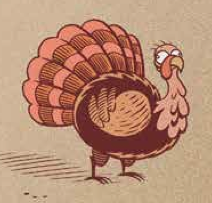 Speaking of weird, here’s a strange question. Why turkeys??
Speaking of weird, here’s a strange question. Why turkeys??
Anthony: That’s a strange question with an obvious answer: This was originally slated to be a Thanksgiving special. And frankly, knowing that makes me just a little bit sadder that it didn’t happen. Thanksgiving has always been the ignored middle child of the Fall/Winter holidays, and that’s especially true when it comes to TV specials. I’m overjoyed at the thought of a great, vintage Muppet special about the holiday.
Joe: It’ll be right up there with Planes, Trains and Automobiles!
Anthony: Yep! That and the Bob Newhart Show episode where Emily goes to Seattle and Bob stays home and watches football. The only two Thanksgiving anythings!
Joe: Moo goo gai pan! Right?? Remember that? Classic Bob.
One thing I wanted to mention was the strange mythology that this book introduces. There’s Timmy, who has some sort of tragic Spider-Man-esque backstory where his parents seem to have abandoned him, but we never really talk about it. There’s a monster-filled meteor that remains dormant for 300 years, and that’s not even mentioning the friendly aliens that live off of rocks and pleasant noises.
Anthony: I’m glad you brought up the monster-filled meteor, because the introductory sequence gives the impression that the book will be an epic science-fiction story. It’s this beautiful, wordless moment of the meteor falling to Earth and then being covered up. At that point, it seems likely they’ll delve into the story of where these creatures are from or what they’re doing on Earth.
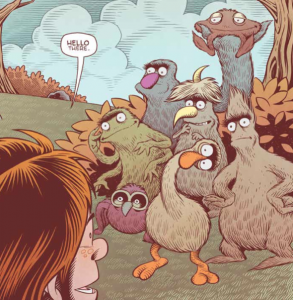 And then it just never comes up again. And frankly, I couldn’t possibly be more thrilled about that. Any explanation that we get would pale in comparison with the jokes and songs and general craziness that we get instead. Basically, the opening set us up for that boring episode of LOST where they explain Jack’s tattoo, but the rest of the book is that one where Hurley finds a Volkswagen van and it’s hilarious.
And then it just never comes up again. And frankly, I couldn’t possibly be more thrilled about that. Any explanation that we get would pale in comparison with the jokes and songs and general craziness that we get instead. Basically, the opening set us up for that boring episode of LOST where they explain Jack’s tattoo, but the rest of the book is that one where Hurley finds a Volkswagen van and it’s hilarious.
Joe: Crazy theory! What if this is the origin story for all the monsters in the Muppet universe? TCKKK is the direct ancestor of Cookie Monster. Sweetums was hidden somewhere in the meteor, but decided to go work at a used car lot rather than hang around a sleepy New Hampshire town. Timmy Henderson grew up to be Timmy Monster, and then wasn’t rebuilt for Muppets Most Wanted!
I agree with you, I never want to see an explanation as to why Monsters exist in Muppet canon, but what if Jim wanted to tell that story? How freaking insane would that be? That’s “Shared Pixar Theory” crazy.
Anthony: It really is! You should make a YouTube video about it.
Joe: Now I’m thinking too much about this. “Turkey Hollow” was written in (and takes place in) 1968, which is just before Sesame Street began. So the monsters are woken up and colorized, and then they hitchhike to New York City to try and make it in public television.
Anthony: And they mysteriously lose their taste for rocks along the way! (Except for Cookie Monster. That guy definitely enjoys a good rock.)
Speaking of rocks, I want to mention how well Langridge’s art sells some of the story’s jokes. The scene where the monsters are in Aunt Cly’s kitchen feasting on rocks (and then passing out) is an excellent example. That’s not a terribly funny idea without the visuals, but Langridge invests it with such a madcap energy that I laughed out loud – the cut from their deranged, chomping faces to their contented sleep is perfect.
Did any visual gags stand out for you?
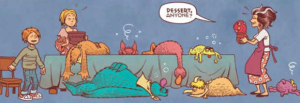 Joe: Absolutely. The biggest ones were when Timmy and the monsters were making music. It’s like when I read comics and see a huge fight scene. Those artists must have to try and come up with a thousand ways to show Batman punching a guy, and to make each one look different and impressive. Langridge has a similar challenge, making the monsters sing and play music (without instruments, by the way) a few times, and I just loved poring over every page of those.
Joe: Absolutely. The biggest ones were when Timmy and the monsters were making music. It’s like when I read comics and see a huge fight scene. Those artists must have to try and come up with a thousand ways to show Batman punching a guy, and to make each one look different and impressive. Langridge has a similar challenge, making the monsters sing and play music (without instruments, by the way) a few times, and I just loved poring over every page of those.
Anthony: And man, how about that final two-page spread that imagines what the set would have looked like while they were shooting the special?
Joe: That was easily the best piece of art in the entire book. It’s so respectful to Jim’s history, recognizing that this story was supposed to be told with puppets, and that Roger Langridge’s adaptation is as close to that as possible. Plus, we get to see Jim and Jerry’s approving faces, as I’m sure they would have felt about this book.
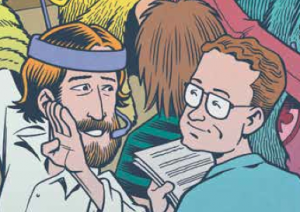 Anthony: Yes! It’s such a nice little touch. Completely unnecessary – we wouldn’t miss it if it hadn’t been there – but it really shows how much love Langridge has for Henson, Juhl, and the whole Muppet family.
Anthony: Yes! It’s such a nice little touch. Completely unnecessary – we wouldn’t miss it if it hadn’t been there – but it really shows how much love Langridge has for Henson, Juhl, and the whole Muppet family.
Joe: There’s also another Jim/Jerry cameo in the book, but I won’t ruin that here. I’ll just make all our readers pay a little closer attention to each panel until they find it.
Anthony: So that just about covers it. Any final thoughts?
Joe: This book is gorgeous, between the artwork (in which Roger Langridge may be doing some of the best work of his career to date) and the great hardbound binding by Archaia. The story is really simple and lovely, and it should resonate for both kids and adults on two very different levels (which is how any good Henson story should be). The characters are Muppety enough to justify putting Jim’s name on the cover (aside from the fact that, y’know, he co-wrote it), but not so much that it looks like a knockoff Muppet project.
Anthony: Absolutely. It’s lovely. It’s a must-own for any Muppet fan, but also for any fan of light-hearted and funny comics. I know that I’ll be purchasing a copy for the middle school library where I work. And, most excitingly, it’s the perfect Thanksgiving gift for the neglected Thanksgiving fan in your life!
The Musical Monsters of Turkey Hollow is now in stores! Go buy!
Click here to make sweet music with the ToughPigs forum!
by Joe Hennes and Anthony Strand

